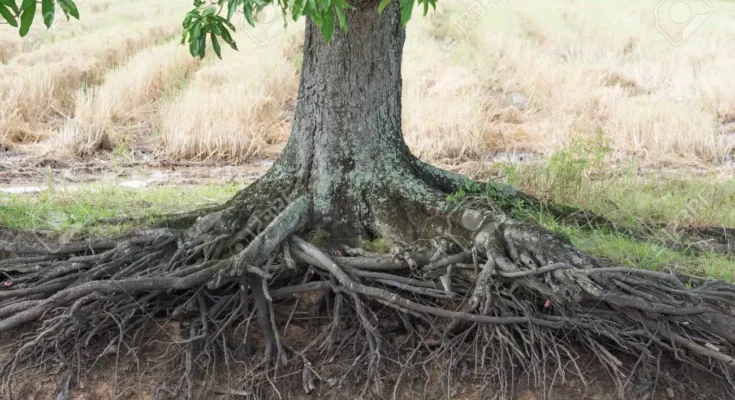Mango trees are popular fruit trees that are grown in many parts of the world. However, some people have concerns about the potential for mango tree roots to be destructive. In this article, we will explore the question of whether mango tree roots are destructive and examine the impact of mango tree roots on the environment, buildings, and other plants.
The Impact of Mango Tree Roots on the Environment
The roots of mango trees can have both positive and negative impacts on the environment. On the positive side, mango tree roots can help to prevent soil erosion by stabilizing the soil and preventing it from washing away. This is due to the deep taproot of the mango tree, which can penetrate deep into the soil and anchor the tree in place. This taproot also helps the tree to access water and nutrients from deep in the soil, even during periods of drought, making it more resilient and less prone to stress during dry spells.
However, the roots of mango trees can also have negative impacts on the environment. If the tree is not properly cared for and allowed to grow uncontrolled, the roots can spread out and cause damage to nearby structures, sidewalks, and other plants. Additionally, the deep taproot of the mango tree can compete with other plants in the soil for water and nutrients, potentially causing damage or stunted growth to other plants in the area.
It is important to plant mango trees in an area with ample space and to provide proper care and maintenance to ensure that the tree’s roots do not cause damage to the environment. Additionally, it is important to avoid planting mango trees near buildings, sidewalks, and other structures, as the lateral roots of the tree can spread out and cause damage if they are allowed to grow too close. By properly planting and caring for mango trees, the positive impacts of their roots on the environment can be maximized and the negative impacts can be minimized.
The Impact of Mango Tree Roots on Buildings
The roots of mango trees can potentially cause damage to buildings and other structures if they are allowed to grow too close. The lateral roots of the mango tree can spread out from the base of the tree, potentially damaging foundations, sidewalks, and other structures. In extreme cases, the roots of the mango tree can even cause cracks in the walls or foundations of buildings.
To prevent damage from mango tree roots, it is important to plant the tree at a safe distance from buildings and other structures. This distance will vary depending on the size of the tree and the type of soil in the area, but a general rule of thumb is to plant the tree at least 10 feet away from any building or structure. If the tree is planted too close to a building, the roots can grow into the foundation or walls and cause damage over time.
In addition to planting the tree at a safe distance from buildings, it is also important to maintain proper care and maintenance of the mango tree. Regular pruning of the tree can help to prevent the roots from spreading too far and causing damage. Additionally, it is important to monitor the growth of the tree and to address any potential issues with the roots before they become a problem.
Overall, the impact of mango tree roots on buildings can be minimized by proper planting and maintenance. By taking the necessary precautions and providing proper care, mango trees can be a beautiful and valuable addition to any landscape without causing damage to buildings or other structures.
The Impact of Mango Tree Roots on Other Plants
The roots of mango trees can have an impact on other plants in the surrounding area, both positive and negative. On the positive side, the deep taproot of the mango tree can help to stabilize the soil and prevent soil erosion, which can benefit other plants in the area. The roots of the mango tree can also help to increase the nutrient levels in the soil, which can make it more fertile and better suited for growing other plants.
However, the roots of mango trees can also have a negative impact on other plants. The deep taproot of the mango tree can compete with other plants for water and nutrients, potentially causing damage or stunted growth to other plants in the area. Additionally, the lateral roots of the mango tree can spread out and potentially damage the roots of other plants or interfere with their growth.
To minimize the impact of mango tree roots on other plants, it is important to plant the tree in an area with ample space and to provide proper care and maintenance. This may include regular pruning of the tree to prevent the roots from spreading too far and causing damage to other plants. Additionally, it is important to choose plants that are well-suited to the growing conditions in the area and to avoid planting other plants too close to the mango tree.
By taking these precautions, the positive impacts of mango tree roots on the environment can be maximized and the negative impacts can be minimized. Additionally, by planting the tree in the right location and providing proper care, mango trees can be a valuable addition to any landscape and can support the growth of other plants in the area.
Conclusion
In conclusion, the roots of mango trees are not inherently destructive. However, they can potentially cause damage to the environment, buildings, and other plants if they are allowed to grow too close. To prevent damage, it is important to plant mango trees at a safe distance from buildings, sidewalks, and other structures and to avoid planting them near other plants. With proper care and attention, mango trees can be a beautiful and valuable addition to any garden or landscape.
Also Read –
How Will 5G Improve The Manufacturing Industry?



